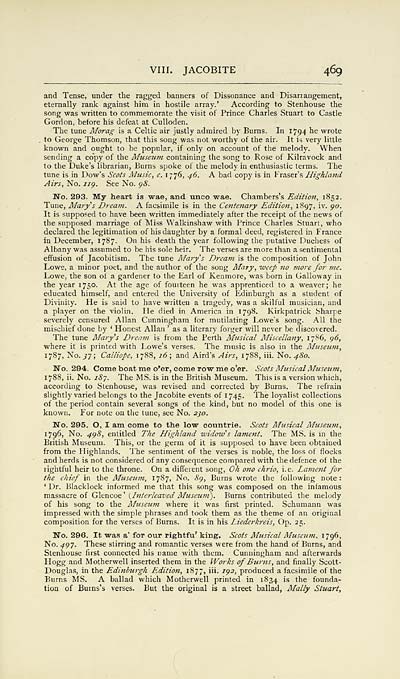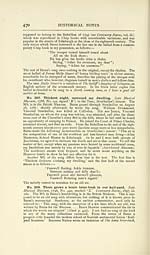Glen Collection of printed music > Printed music > Songs of Robert Burns
(525) Page 469
Download files
Complete book:
Individual page:
Thumbnail gallery: Grid view | List view

VIII. JACOBITE 469
and Tense, under the ragged banners of Dissonance and Disarrangement,
eternally rank against him in hostile array.' According to Stenhouse the
song was written to commemorate the visit of Prince Charles Stuart to Castle
Gordon, before his defeat at CuUoden.
The tune Morag is a Celtic air justly admired by Burns. In 1794 iie wrote
to George Thomson, that this song was not worthy of the air. It is very little
known and ought to be popular, if only on account of the melody. When
sending a copy of the Musemn containing the song to Rose of Kilravock and
to the Duke's librarian, Burns spoke of the melody in enthusiastic terms. The
tune is in Dow's Scots Music, c. 1776, 46. A bad copy is in Eraser's Highland
Airs, No. iig. See No. p<S.
No. 293. My heart is wae, and unco wae. Chambers's Edition, 1852.
Tune, Alat-ys Dream. A facsimile is in the Centenary Edition, 1897, iv. 90.
It is supposed to have been written immediately after the receipt of the news of
the supposed marriage of Miss Walkinshaw with Prince Charles Stuart, who
declared the legitimation of his daughter by a formal deed, registered in France
in December, 1787. On his death the year following the putative Duchess of
Albany was assumed to be his sole heir. The verses are more than a sentimental
effusion of Jacobitism. The tune Mary's Dream is the composition of John
Lowe, a minor poet, and the author of the song Mary, weep no tnore for me.
Lowe, the son of a gardener to the Earl of Kenmore, was bom in Galloway in
the year 1750. At the age of fourteen he was apprenticed to a weaver; he
educated himself, and entered the University of Edinburgh as a student of
Divinity. He is said to have written a tragedy, was a skilful musician, and
a player on the violin. He died in America in 1798. Kirkpatrick Sharpe
severely censured Allan Cunningham for mutilating Lowe's song. All the
mischief done by ' Honest Allan ' as a literary forger will never be discovered.
The tune Mary's Dream is from the Perth Musical Miscellany, 1786, <)6,
where it is printed with Lowe's verses. The music is also in the Musetitn,
1787, No. ^7; Calliope, 1788, 16 ; and Aird's Airs, 1788, iii. No. 480.
No. 294. Come boat me o'er, come row me o'er. Scots Mtisical Museum,
1788, ii. No. 187. The MS. is in the British Museum. This is a version which,
according to Slenhouse, was revised and corrected by Burns. The refrain
slightly varied belongs to the Jacobite events of 1745. The loyalist collections
of the period contain several songs of the kind, but no model of this one is
known. For note on the lune, see No. 2jo.
No. 295. O, I am come to the low countrie. Scots Musical Mziseum,
1796, No. 4^8, entitled The Highland •widow'' s lament. The MS. is in the
British Museum. This, or the germ of it is supposed to have been obtained
from the Highlands. The sentiment of the verses is noble, the loss of flocks
and herds is not considered of any consequence compared with the defence of the
rightful heir to the throne. On a different song, Oh ono chrio, i.e. La?jient for
the chief in the Museum, 1787, No. 8(), Bums wrote the following note:
' Dr. Blacklock informed me that this song was composed on the infamous
massacre of Glencoe ' {Interleaved Museum). Burns contributed the melody
of his song to the Mtiseu?n where it was first printed. Schumann was
impressed with the simple phrases and took them as the theme of an original
composition for the verses of Burns. It is in his Liederkreis, Op. 25.
No. 296. It was a' for our rightfu' king. Scots Mtisical Museum, 1796,
No. ^97. These stirring and romantic verses were from the hand of Burns, and
Stenhouse first connected his name with them. Cunningham and afterwards
Hogg and Motherwell inserted them in the Works of Bui'ns, and finally Scott-
Douglas, in the Edinburgh Edition, 1877, iii. 1^2, produced a facsimile of the
Bums MS. A ballad which Motherwell printed in 1834 is the founda-
tion of Burns's verses. But the original is a street ballad, Mally Stuart,
and Tense, under the ragged banners of Dissonance and Disarrangement,
eternally rank against him in hostile array.' According to Stenhouse the
song was written to commemorate the visit of Prince Charles Stuart to Castle
Gordon, before his defeat at CuUoden.
The tune Morag is a Celtic air justly admired by Burns. In 1794 iie wrote
to George Thomson, that this song was not worthy of the air. It is very little
known and ought to be popular, if only on account of the melody. When
sending a copy of the Musemn containing the song to Rose of Kilravock and
to the Duke's librarian, Burns spoke of the melody in enthusiastic terms. The
tune is in Dow's Scots Music, c. 1776, 46. A bad copy is in Eraser's Highland
Airs, No. iig. See No. p<S.
No. 293. My heart is wae, and unco wae. Chambers's Edition, 1852.
Tune, Alat-ys Dream. A facsimile is in the Centenary Edition, 1897, iv. 90.
It is supposed to have been written immediately after the receipt of the news of
the supposed marriage of Miss Walkinshaw with Prince Charles Stuart, who
declared the legitimation of his daughter by a formal deed, registered in France
in December, 1787. On his death the year following the putative Duchess of
Albany was assumed to be his sole heir. The verses are more than a sentimental
effusion of Jacobitism. The tune Mary's Dream is the composition of John
Lowe, a minor poet, and the author of the song Mary, weep no tnore for me.
Lowe, the son of a gardener to the Earl of Kenmore, was bom in Galloway in
the year 1750. At the age of fourteen he was apprenticed to a weaver; he
educated himself, and entered the University of Edinburgh as a student of
Divinity. He is said to have written a tragedy, was a skilful musician, and
a player on the violin. He died in America in 1798. Kirkpatrick Sharpe
severely censured Allan Cunningham for mutilating Lowe's song. All the
mischief done by ' Honest Allan ' as a literary forger will never be discovered.
The tune Mary's Dream is from the Perth Musical Miscellany, 1786, <)6,
where it is printed with Lowe's verses. The music is also in the Musetitn,
1787, No. ^7; Calliope, 1788, 16 ; and Aird's Airs, 1788, iii. No. 480.
No. 294. Come boat me o'er, come row me o'er. Scots Mtisical Museum,
1788, ii. No. 187. The MS. is in the British Museum. This is a version which,
according to Slenhouse, was revised and corrected by Burns. The refrain
slightly varied belongs to the Jacobite events of 1745. The loyalist collections
of the period contain several songs of the kind, but no model of this one is
known. For note on the lune, see No. 2jo.
No. 295. O, I am come to the low countrie. Scots Musical Mziseum,
1796, No. 4^8, entitled The Highland •widow'' s lament. The MS. is in the
British Museum. This, or the germ of it is supposed to have been obtained
from the Highlands. The sentiment of the verses is noble, the loss of flocks
and herds is not considered of any consequence compared with the defence of the
rightful heir to the throne. On a different song, Oh ono chrio, i.e. La?jient for
the chief in the Museum, 1787, No. 8(), Bums wrote the following note:
' Dr. Blacklock informed me that this song was composed on the infamous
massacre of Glencoe ' {Interleaved Museum). Burns contributed the melody
of his song to the Mtiseu?n where it was first printed. Schumann was
impressed with the simple phrases and took them as the theme of an original
composition for the verses of Burns. It is in his Liederkreis, Op. 25.
No. 296. It was a' for our rightfu' king. Scots Mtisical Museum, 1796,
No. ^97. These stirring and romantic verses were from the hand of Burns, and
Stenhouse first connected his name with them. Cunningham and afterwards
Hogg and Motherwell inserted them in the Works of Bui'ns, and finally Scott-
Douglas, in the Edinburgh Edition, 1877, iii. 1^2, produced a facsimile of the
Bums MS. A ballad which Motherwell printed in 1834 is the founda-
tion of Burns's verses. But the original is a street ballad, Mally Stuart,
Set display mode to: Large image | Transcription
Images and transcriptions on this page, including medium image downloads, may be used under the Creative Commons Attribution 4.0 International Licence unless otherwise stated. ![]()
| Special collections of printed music > Glen Collection of printed music > Printed music > Songs of Robert Burns > (525) Page 469 |
|---|
| Permanent URL | https://digital.nls.uk/91265942 |
|---|
| Description | Scottish songs and music of the 18th and early 19th centuries, including music for the Highland bagpipe. These are selected items from the collection of John Glen (1833 to 1904). Also includes a few manuscripts, some treatises, and other books on the subject. |
|---|
| Description | The Glen Collection and the Inglis Collection represent mainly 18th and 19th century Scottish music, including Scottish songs. The collections of Berlioz and Verdi collected by bibliographer Cecil Hopkinson contain contemporary and later editions of the works of the two composers Berlioz and Verdi. |
|---|

